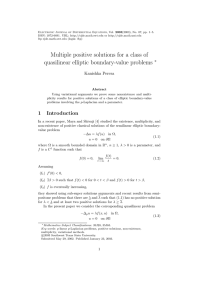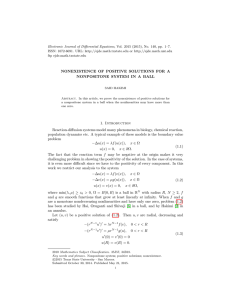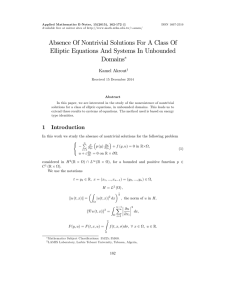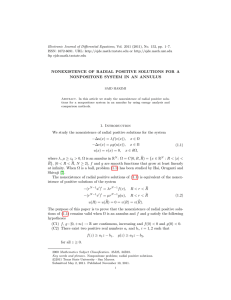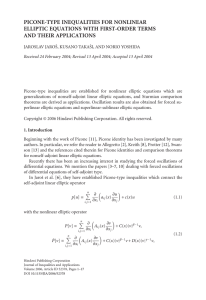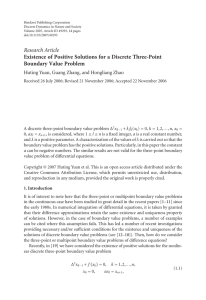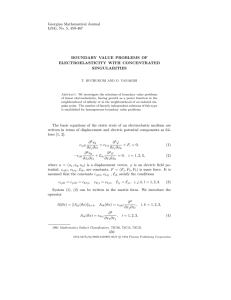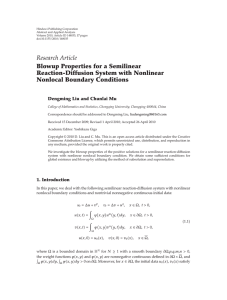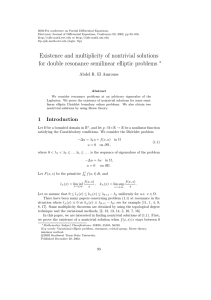Electronic Journal of Differential Equations, Vol. 2009(2009), No. 02, pp.... ISSN: 1072-6691. URL: or
advertisement
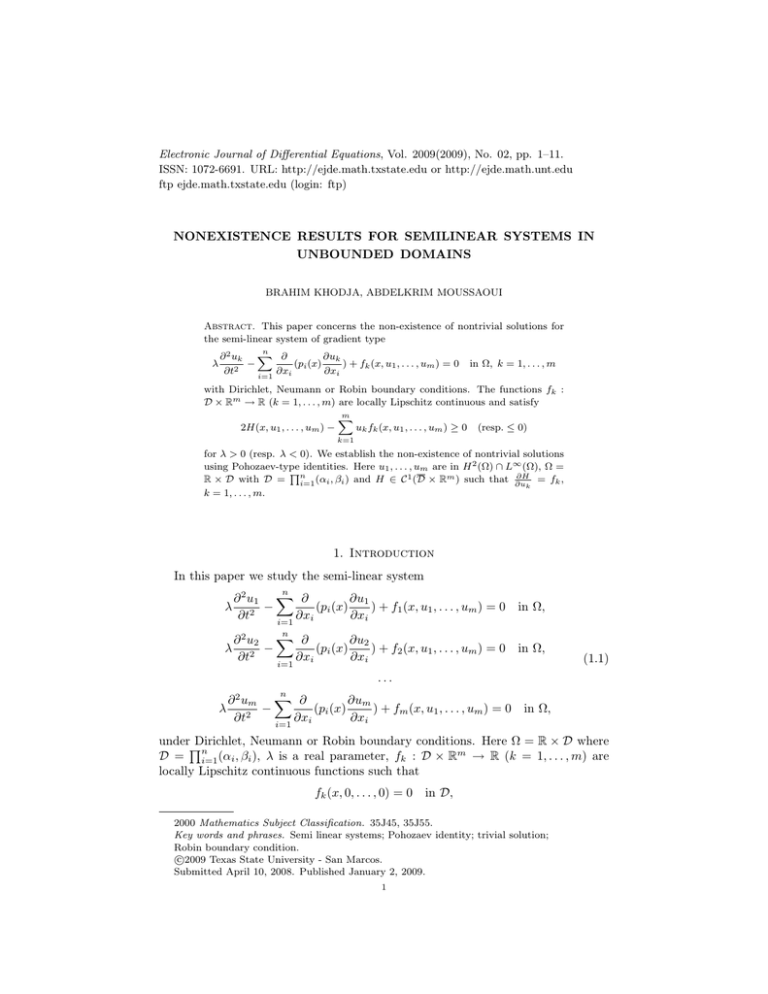
Electronic Journal of Differential Equations, Vol. 2009(2009), No. 02, pp. 1–11.
ISSN: 1072-6691. URL: http://ejde.math.txstate.edu or http://ejde.math.unt.edu
ftp ejde.math.txstate.edu (login: ftp)
NONEXISTENCE RESULTS FOR SEMILINEAR SYSTEMS IN
UNBOUNDED DOMAINS
BRAHIM KHODJA, ABDELKRIM MOUSSAOUI
Abstract. This paper concerns the non-existence of nontrivial solutions for
the semi-linear system of gradient type
n
λ
X ∂
∂ 2 uk
∂uk
−
(pi (x)
) + fk (x, u1 , . . . , um ) = 0
∂t2
∂x
∂xi
i
i=1
in Ω, k = 1, . . . , m
with Dirichlet, Neumann or Robin boundary conditions. The functions fk :
D × Rm → R (k = 1, . . . , m) are locally Lipschitz continuous and satisfy
2H(x, u1 , . . . , um ) −
m
X
uk fk (x, u1 , . . . , um ) ≥ 0
(resp. ≤ 0)
k=1
for λ > 0 (resp. λ < 0). We establish the non-existence of nontrivial solutions
using Pohozaev-type identities. Here u1 , . . . , um are in H 2 (Ω) ∩ L∞ (Ω), Ω =
Q
∂H
m
1
R × D with D = n
i=1 (αi , βi ) and H ∈ C (D × R ) such that ∂uk = fk ,
k = 1, . . . , m.
1. Introduction
In this paper we study the semi-linear system
n
λ
∂ 2 u1 X ∂
∂u1
−
(pi (x)
) + f1 (x, u1 , . . . , um ) = 0
∂t2
∂x
∂xi
i
i=1
in Ω,
n
∂ 2 u2 X ∂
∂u2
λ 2 −
(pi (x)
) + f2 (x, u1 , . . . , um ) = 0
∂t
∂x
∂xi
i
i=1
in Ω,
(1.1)
...
n
∂um
∂ 2 um X ∂
−
(pi (x)
) + fm (x, u1 , . . . , um ) = 0
λ
∂t2
∂x
∂xi
i
i=1
in Ω,
underQ
Dirichlet, Neumann or Robin boundary conditions. Here Ω = R × D where
n
D = i=1 (αi , βi ), λ is a real parameter, fk : D × Rm → R (k = 1, . . . , m) are
locally Lipschitz continuous functions such that
fk (x, 0, . . . , 0) = 0
in D,
2000 Mathematics Subject Classification. 35J45, 35J55.
Key words and phrases. Semi linear systems; Pohozaev identity; trivial solution;
Robin boundary condition.
c
2009
Texas State University - San Marcos.
Submitted April 10, 2008. Published January 2, 2009.
1
2
B. KHODJA, A. MOUSSAOUI
EJDE-2009/02
so that (u1 , . . . , um ) = 0 is a solution of (1.1) and pi : D → R (i = 1, . . . , n) are
continuous functions satisfying
pi (x) > 0 or pi (x) < 0
in D.
We assume that system (1.1) is of the gradient type; that is, there is a real-valued
differentiable function H(x, u1 , . . . , um ) such that
∂H
= fk ,
∂uk
H(x, 0, . . . , 0) = 0
for x ∈ D.
For k = 1, . . . , m, uk are in H 2 (Ω) ∩ L∞ (Ω) and satisfy
uk (t, s) = 0,
(t, s) ∈ R × ∂D
(1.2)
(Dirichlet boundary condition), or
∂uk (t, s)
= 0,
∂n
(Neumann boundary condition), or
(t, s) ∈ R × ∂D
(1.3)
∂uk
)(t, s) = 0, (t, s) ∈ R × ∂D
(1.4)
∂n
(Robin boundary condition), where ε is a positive real number. Throughout this
paper we denote the boundary of Ω by
(uk + ε
∂Ω = R × ∂D = Γα1 ∪ Γβ1 ∪ Γα2 ∪ Γβ2 · · · ∪ Γαn ∪ Γβn ,
where
Γµs = {(t, x1 , . . . , xs−1 , µs , xs+1 , . . . xn ), t ∈ R,
1 ≤ s ≤ n} ,
(t, x) = (t, x1 , . . . , xn ), and
n(t, s) = (0, n1 (t, s), n2 (t, s), . . . , nn (t, s))
Qn
is the outward normal to ∂Ω at the point (t, s). If x ∈ i=1 (αi , βi ), l = 1, 2, . . . , n
and τ ∈ {α1 , β1 , α2 , β2 , . . . , αn , βn } one writes
xτl = (x1 , . . . , xl−1 , τ, xl+1 , . . . , xn ),
dx∗l = dx1 . . . dxl−1 dxl+1 . . . dxn
and
Z
β1
Z
βi−1
Z
βi+1
...
α1
αi−1
Z
=
Di∗
Z
βn
...
αi+1
fk (x, r1 , . . . , rm )dx1 . . . dxi−1 dxi+1 . . . dxn
αn
fk (x, r1 , . . . , rm )dx∗i
for all k = 1, . . . , m.
The question of non-existence of nontrivial solutions for elliptic problems has
been studied extensively in both bounded and unbounded domain (see [3],[4],[7]-[9]
and their references). In particular, Amster et al. in [1] showed the non-solvability
of the gradient elliptic system
−∆ui = gi (u)
in Ω,
ui = 0 on ∂Ω, i = 1, . . . , n,
where Ω is a starshaped domain. A similar result was given for Hamiltonian systems
by N. M. Chuong and T. D. Ke [2] in k-starshaped domain and by Khodja [6] in
unbounded domain R+ × R.
EJDE-2009/02
NONEXISTENCE RESULTS FOR SEMILINEAR SYSTEMS
3
In the scalar case, when Ω is an unbounded domain, Haraux and Khodja [4]
established that under assumptions
f (0) = 0,
2F (u) − uf (u) ≤ 0,
(F (u) =
Ru
0
u 6= 0
f (s)ds), the problem
−∆u + f (u) = 0
in Ω,
∂u
) = 0 on ∂Ω,
∂n
has only a trivial solution in H 2 (Ω) ∩ L∞ (Ω), where Ω = J × ω, J ⊂ R is an
unbounded interval and ω a domain in RN . The case of Robin boundary conditions
was treated by Khodja [5] and it was shown nonexistence results for the equation
(u or
λ
∂
∂u ∂
∂u ∂2u
−
p(x, y)
−
q(x, y)
+ f (x, y, u) = 0
2
∂t
∂x
∂x
∂y
∂y
in Ω,
where Ω = R×]α1 , β1 [×]α2 , β2 [. In the above works, the integral identity of
Pohozaev was adapted for each problem treated and applied to obtain the nonexistence results. The present study extends and complements these works. We
shall prove the non-solvability results to the class of semi-linear system of gradient
type (1.1) under Dirichlet, Neumann or Robin boundary conditions. By using a
Pohozaev-type identity, our demonstration strategy will be to show that the function
Z X
m
|uk (t, x)|2 dx
E(t) =
D
k=1
is convex in R, and then, from the Maximum Principle, we obtain that any solution
(u1 , . . . , um ) to the problems (1.1)-(1.2), (1.1)-(1.3) and (1.1)-(1.4) is trivial. We
draw the attention of the reader to the use of the Pohozaev-type identity which,
to the best of our knowledge, was not explored before in connection with gradient
systems in an unbounded cylindrical-type domain.
This paper is organized as follows. In the next section, we give a Pohozaev-type
identity adapted to the systems with Dirichlet, Neumann and Robin boundary
conditions; section 3 gives our main results and some examples will be illustrated
in section 4.
2. Integral identities
The proof of our main results which will appear in the next section use the
following type of Pohozaev identity, adapted for systems.
Theorem 2.1. Let u1 , . . . , um in H 2 (Ω) ∩ L∞ (Ω) be a solution of problem (1.1)–
(1.4). Then for each t ∈ R and ε > 0, we have
Z h X
m
n
m
i
λ
∂uk 2 X pi (x) X ∂uk 2 |
| +
|
| + H(x, u1 , . . . , um ) dx
2
∂xi
D 2 k=1 ∂t
i=1
k=1
n Z
m
m
h
i
X
X
1 X
αi
2
i
|uk |2 (t, xβi i ) + pi (xα
)
|u
|
(t,
x
)
dx∗i = 0.
+
pi (xβi i )
k
i
i
2ε i=1 Di∗
k=1
k=1
(2.1)
4
B. KHODJA, A. MOUSSAOUI
EJDE-2009/02
Proof. For t ∈ R we consider a function
Z
m
n
m
λ X
∂uk 2 X pi (x) X ∂uk 2
K(t) =
|
| +
(
| ) + H(x, u1 , . . . , um ) dx.
|
2
∂t
2
∂x
i
D
i=1
k=1
k=1
The hypothesis on uk , fk (k = 1, . . . , m) and pi (i = 1, . . . , n) implies that K is
absolutely continuous and thus differentiable almost everywhere on R; we have
Z
n
m
m
X
X
∂uk ∂ 2 uk dK(t)
∂uk ∂ 2 uk X
+
=
p
(x)
λ
i
dt
∂t ∂t2
∂xi ∂t∂xi
D
i=1
k=1
k=1
(2.2)
m
X
∂uk
+
fk (x, u1 , . . . , um ) dx.
∂t
k=1
Fubini’s theorem and an integration by part give
Z X
m
n
X
∂uk ∂ 2 uk (t, x)dx
pi (x)
∂xi ∂t∂xi
D i=1
k=1
Z X
n
m
X
∂
∂uk ∂uk =−
(t, x)dx
(pi (x)
)
∂xi ∂t
D i=1 k=1 ∂xi
m
n Z
m
X
X
X
∗
∂uk ∂uk
∂uk ∂uk i
i
pi (xβi i )(
+
)(t, xβi i ) − pi (xα
)
(t, xα
i
i ) dxi .
∗
∂xi ∂t
∂xi ∂t
i=1 Di
k=1
k=1
Replacing in (2.2) we find
dK(t)
dt
m Z h
n
i
X
∂ 2 uk X ∂
∂uk
∂uk
dx
λ 2 −
=
(pi (x)
) + fk (x, u1 , . . . , um ) (t, x)
∂t
∂xi
∂xi
∂t
i=1
k=1 D
m
n Z
m
X
h
i
X
X
∂uk ∂uk ∂uk ∂uk
αi
i
+
)(t, xβi i ) − pi (xα
)
pi (xβi i )(
(t,
x
)
dx∗i .
i
i
∗
∂x
∂t
∂x
∂t
i
i
D
i
i=1
k=1
k=1
k
Let us consider on ∂Ω the expression uk + ε ∂u
∂n = 0. For k = 1, . . . , m
αi
∂uk
(uk − ε ∂x )(t, xi ) = 0,
∂uk
βi
k
= 0 ⇐⇒ (uk + ε ∂u
uk + ε
∂x )(t, xi ) = 0,
∂n
t ∈ R, αi < xi < βi , i = 1, . . . n.
Then for ε > 0, one can write
n Z
m
m
h
X
i
X
X
∂uk ∂uk ∂uk ∂uk αi
i
pi (xβi i )
(t, xβi i ) − pi (xα
)
(t,
x
)
dx∗i
i
i
∗
∂x
∂t
∂x
∂t
i
i
D
i
i=1
k=1
k=1
n Z
m
m
h
i
X
X
X
−1
∂uk
∂uk ∗
i
i
=
pi (xβi i )( uk
)(t, xβi i ) + pi (xα
(t, xα
)
uk
i
i ) dxi
ε i=1 Di∗
∂t
∂t
k=1
k=1
n Z
m
m
i
h
X
X
X
−1 d
∗
i
i
=
(
pi (xβi i )(
|uk |2 )(t, xβi i ) + pi (xα
|uk |2 (t, xα
i )
i ) dxi ).
2ε dt i=1 Di∗
k=1
k=1
EJDE-2009/02
NONEXISTENCE RESULTS FOR SEMILINEAR SYSTEMS
5
Therefore,
n
1 X
d
K(t) +
dt
2ε i=1
i
+ pi (xα
i )(
m
X
Z
Di∗
h
pi (xβi i )(
m
X
|uk |2 )(t, xβi i )
k=1
i
∗
i
= 0.
|uk |2 )(t, xα
i ) dxi
k=1
Integrating with respect to t, we obtain
m
n Z
h
X
1X
K(t) +
|uk |2 (t, xβi i )
pi (xβi i )
2ε i=1 Di∗
k=1
i
+ pi (xα
i )
m
X
i
i
|uk |2 (t, xα
)
dx∗i = const
i
k=1
and since (u1 (t, x), . . . , um (t, x)) ∈ (H 2 (Ω) ∩ L∞ (Ω))m , one must get
Z
n Z
m
h
X
1 X
(K(t) +
pi (xβi i )(
|uk |2 )(t, xβi i )
2ε i=1 Di∗
R
k=1
i
+ pi (xα
i )
m
X
i
∗
i
|uk |2 (t, xα
i ) dxi )dt < ∞.
k=1
It follows that the constant must be 0, which is the desired result.
For the Dirichlet or Neumann boundary conditions, we have the integral identity
given in the following theorem.
Theorem 2.2. Let u1 , . . . , um in H 2 (Ω) ∩ L∞ (Ω) be a solution of problems (1.1)(1.2) or (1.1)-(1.3). Then for each t ∈ R, we have
Z h X
m
n
m
i
λ
∂uk 2 X pi (x) X ∂uk 2 |
|
| +
| + H(x, u1 , . . . , um ) dx = 0.
(2.3)
∂t
2
∂xi
D 2
i=1
k=1
k=1
Proof. To prove (2.3) it suffices to check that the expression
m
m
n Z
i
h
X
X
X
αi
2
i
|uk |2 (t, xβi i ) + pi (xα
)
|u
|
(t,
x
)
dx∗i
pi (xβi i )
k
i
i
i=1
Di∗
k=1
k=1
vanishes if
u1 (t, s) = u2 (t, s) = · · · = um (t, s) = 0, (t, s) ∈ R × ∂D
(2.4)
or
∂u1 (t, s)
∂u2 (t, s)
∂um (t, s)
=
= ··· =
= 0, (t, s) ∈ R × ∂D.
∂n
∂n
∂n
Indeed, suppose that (2.4) holds then it is known that
∇uk =
∂uk
· n,
∂n
k = 1, . . . , m;
i.e.,
∂uk
∂t (t, s)
∂uk (t, s)
∂x1
0
n1 ∂uk (t, s)
∂n
,
=
...
...
∂uk
∂uk
nn ∂n (t, s)
∂xn (t, s)
(t, s) ∈ R × ∂D,
k = 1, . . . , m.
(2.5)
6
B. KHODJA, A. MOUSSAOUI
EJDE-2009/02
Consequently, for k = 1, . . . , m,
∂uk
∂uk
i
(t, xα
(t, xβi i ) = 0, i = 1, . . . , n.
i )=
∂t
∂t
Now if the boundary condition is (2.5), then for k = 1, . . . , m, one can write
0=
∂uk
(t, s) = h∇uk , ni on Γα1 ∪ Γβ1 ∪ Γα2 ∪ Γβ2 · · · ∪ Γαn ∪ Γβn ;
∂n
i.e.,
∂uk
∂uk
i
(t, xα
(t, xβi i ) = 0,
i )=
∂xi
∂xi
In both cases
dK(t)
dt
for all t ∈ R,
i = 1, . . . , n, k = 1, . . . , m.
= 0 for all t ∈ R which completes the proof.
3. Main results
Before giving our main results, we note that the parameter λ plays, in fact, an
important part as it allows (1.1) to be dealt with in two manners based on whether
its value is positive or negative. Indeed, if λ is positive (resp. negative), the system
(1.1) is a hyperbolic (resp. elliptic) problem.
3.1. Semi-linear hyperbolic problems. Using identity (2.1) we obtain the following first result.
Theorem 3.1. Let λ > 0 and u1 , . . . , um ∈ H 2 (Ω) ∩ L∞ (Ω). Assume pi (x) > 0 in
D (i = 1, . . . , n) and fk (k = 1, . . . , m) satisfying
H(x, u1 , . . . , um ) ≥ 0.
Then problems (1.1)-(1.2), (1.1))-(1.3) and (1.1)-(1.4) have no nontrivial solutions.
Proof. Applying formula (2.1) (resp. (2.3)) we immediately obtain
∂uk
∂uk
(t, x) =
(t, x) = 0 in Ω, i = 1, . . . , n, k = 1, . . . , m.
∂t
∂xi
Thus u1 , . . . , um are constant and since for k = 1, . . . , m,
Z
|uk (t, x)|2 dxdt ≤ 0,
Ω
these constants are necessarily zero.
The next theorem gives a non-existence result if the functions fk (k = 1, . . . , m)
satisfy another type of non-linearity.
Theorem 3.2. Let λ > 0 and u1 , . . . , um : Ω → R be a solution of problem (1.1)(1.4). Suppose that u1 , . . . , um ∈ H 2 (Ω) ∩ L∞ (Ω) and fk (k = 1, . . . , m) verify the
following condition
m
X
2H(x, u1 , . . . , um ) −
uk fk (x, u1 , . . . , um ) ≥ 0.
(3.1)
k=1
Then problem (1.1)-(1.4) has no nontrivial solutions.
Remark 3.3. Since u1 , . . . , um are bounded in Ω, from the Maximum Principle,
the function E(t) is convex in R which implies that the solution to the problem
(1.1)-(1.4) is identically equal to zero.
EJDE-2009/02
NONEXISTENCE RESULTS FOR SEMILINEAR SYSTEMS
7
Proof of Theorem 3.2. It is easy to see that almost everywhere in Ω
(uk
1 ∂ 2 (u2 )
∂ 2 uk
∂uk 2 k
)(t,
x)
=
−
|
| (t, x),
∂t2
2 ∂t2
∂t
k = 1, . . . , m.
Let us multiply the k-th equation of (1.1) by uk /2 and integrate over D we obtain
Z h 2
n
∂ uk uk X ∂
∂uk uk
uk i
λ 2
(t, x)dx
−
(pi (x)
)
+ fk (x, u1 , . . . , um )
∂t 2
∂xi
∂xi 2
2
D
i=1
Z
λ ∂ 2 (u2k ) λ ∂uk 2 =
− |
| (t, x)dx
2
2 ∂t
D 4 ∂t
Z h X
n
uk i
∂uk uk
∂
(t, x)dx.
(pi (x)
)
+ f (x, u1 , . . . , um )
+
−
∂xi
∂xi 2
2
D
i=1
(3.2)
Let us transform
Z D
n
X
∂
∂uk uk −
(t, x)dx
(pi (x)
)
∂xi
∂xi 2
i=1
Z X
n
pi (x) ∂uk (t, x) 2
=
|
| dx
2
∂xi
D i=1
n Z
h
i
1X
∂uk
∂uk
αi
i
−
pi (xβi i )(uk
)(t, xβi i ) − pi (xα
)(u
)(t,
x
)
dx∗i .
k
i
i
2 i=1 Di∗
∂xi
∂xi
The substitution of this formula in (3.2) gives
Z h 2
n
∂uk uk
uk i
∂ uk uk X ∂
−
(pi (x)
)
+ f (x, u1 , . . . , um )
(t, x)dx
λ 2
∂t 2
∂xi
∂xi 2
2
D
i=1
Z λ ∂ 2 (u2k ) λ ∂uk 2 =
− |
| (t, x)dx
2
2 ∂t
D 4 ∂t
Z X
Z
n
uk
pi (x) ∂uk (t, x) 2
|
| dx + ( f (x, u1 , . . . , um ))(t, x)dx
+
2
∂xi
D 2
D i
Z
n
h
i
∂uk
1X
∂uk
αi
i
pi (xβi i )(uk
)(t, xβi i ) − pi (xα
)(t,
x
)
dx∗i
−
)(u
k
i
i
2 i=1 Di∗
∂xi
∂xi
Z
λ ∂ 2 (u2k ) λ ∂uk 2
=
(
− |
| )(t, x)dx
2
2 ∂t
D 4 ∂t
Z X
Z
n
pi (x) ∂uk (t, x) 2
uk
+
|
| dx + ( f (x, u1 , . . . , um ))(t, x)dx
2
∂x
i
D i=1
D 2
Z
n
h
i
1 X
αi 2
i
+
pi (xβi i )|uk (t, xβi i )|2 + pi (xα
dx∗i .
i )|uk (t, xi )|
2ε i=1 Di∗
(3.3)
8
B. KHODJA, A. MOUSSAOUI
EJDE-2009/02
Adding these identities for k = 1, . . . , k0 , we get
Z X
Z X
m
m
λ
λ
∂ 2 (u2k ) ∂uk 2 (t,
x)dx
−
| (t, x)dx
|
4 D
∂t2
2 D
∂t
k=1
k=1
Z X
Z X
n
m
m
pi (x) X ∂uk 2
1
+
(
| )(t, x)dx +
(
|
uk fk (x, u1 , . . . , um ))(t, x)dx
2
∂xi
2 D
D i=1
k=1
n
+
1 X
2ε i=1
Z
h
Di∗
pi (xβi i )
k=1
m
X
m
i
X
∗
i
i
)
|uk |2 (t, xα
|uk |2 (t, xβi i ) + pi (xα
i ) dxi = 0,
i
k=1
k=1
which combined with (2.1) yields
Z X
Z X
Z h
m
m
λ d2 ∂uk 2
2
u
(t,
x)dx
=
λ
(
|
|
)(t,
x)dx
+
H(x, u1 , . . . , um )
k
4 dt2 D
∂t
D
D
k=1
k=1
m
i
1 X
− (
uk fk (x, u1 , . . . , um ))(t, x, y) dx.
2
k=1
(3.4)
The assumptions (3.1) and λ > 0 enable us to assert that
Z X
Z X
m
m
∂uk 2 λ d2 2
|
| (t, x)dx ≥ 0,
u
(t,
x)dx
≥
λ
k
4 dt2 D
∂t
D
k=1
k=1
for all t ∈ R. This completes the proof.
Theorem 3.4. Let λ > 0 and fk be as described in Theorem 3.2. Assume that
u1 , . . . , um ∈ H 2 (Ω) ∩ L∞ (Ω) is a solution of (1.1)-(1.2) or (1.1)-(1.3). Then
problems (1.1))-(1.2) and (1.1)-(1.3) have no nontrivial solutions.
Proof. By a similar arguments as in the proof of Theorem 3.2 we obtain
Z X
Z X
m
m
∂ 2 (u2k ) ∂uk 2 λ
λ
|
| (t, x)dx
(t,
x)dx
−
4 D
∂t2
2 D
∂t
k=1
k=1
Z X
n
m
pi (x) X ∂uk 2 +
|
| (t, x)dx
2
∂xi
D i=1
k=1
Z X
m
1
uk fk (x, u1 , . . . , um ) (t, x)dx
+
2 D
k=1
n Z
m
m
h
i
X
X
1 X
αi
2
i
+
pi (xβi i )
|uk |2 (t, xβi i ) + pi (xα
)
|u
|
(t,
x
)
dx∗i = 0.
k
i
i
2ε i=1 Di∗
k=1
k=1
If
u1 (t, s) = · · · = um (t, s) = 0,
(t, s) ∈ R × ∂D
or
∂um (t, s)
∂u1 (t, s)
= ··· =
= 0, (t, s) ∈ R × ∂D,
∂n
∂n
this formula reduces to
Z X
Z X
m
m
λ
∂ 2 (u2k ) λ
∂uk 2 (t,
x)dx
−
|
| (t, x)dx
4 D
∂t2
2 D
∂t
k=1
k=1
EJDE-2009/02
NONEXISTENCE RESULTS FOR SEMILINEAR SYSTEMS
9
Z X
m
n
pi (x) X ∂uk 2 +
|
| (t, x)dx
2
∂xi
D i=1
k=1
Z X
m
1
+
uk fk (x, u1 , . . . , um ) (t, x)dx = 0.
2 D
k=1
We can now employ (2.3) to transform this identity into the form
λ
4
Z X
m
∂ 2 (u2 ) k
D
k=1
∂t2
(t, x)dx
Z X
m
∂uk 2 | (t, x)dx
|
D k=1 ∂t
Z h
m
i
1 X
+
H(x, u1 , . . . , um ) −
uk fk (x, u1 , . . . , um ) (t, x, y) dx .
2
D
=λ
(3.5)
k=1
This completes the proof.
3.2. Semi-linear elliptic problems. We shall prove that a dual result holds for
λ < 0.
Theorem 3.5. Let (u1 , . . . , um ) ∈ (H 2 (Ω)∩L∞ (Ω))m be a solution of (1.1))-(1.4),
λ < 0 and fk (k = 1, . . . , m) satisfying
2H(x, u1 , . . . , um ) −
m
X
uk fk (x, u1 , . . . , um ) ≤ 0.
(3.6)
k=1
Then problem (1.1)-(1.4) has no nontrivial solutions.
Proof. Formula (3.4) combined with the assumption (3.6) yields
λ d2 4 dt2
Z
D
m
X
k=1
Z X
m
∂uk 2 |
u2k (t, x)dx ≤ λ
| (t, x)dx,
∂t
D
for all t ∈ R
k=1
and λ < 0 gives the desired result.
Theorem 3.6. Let λ < 0 and fk (k = 1, . . . , m) be as described in Theorem 3.5.
We assume that
u1 , . . . , um ∈ H 2 (Ω) ∩ L∞ (Ω)
is a solution of (1.1)-(1.2) or 1.1-(1.3). Then problems (1.1)-(1.2) and (1.1)-(1.3)
have no nontrivial solutions.
This theorem follows from (3.5) and (3.6) with λ < 0.
4. Examples
In this section, we illustrate our theoretical results by giving some examples.
10
B. KHODJA, A. MOUSSAOUI
EJDE-2009/02
Example 1. Let θ : D → R be a continuous function, the exponents αs > 0,
s = 1, . . . , m and
pi (x) > 0
or pi (x) < 0 in D,
i = 1, . . . , n.
Then system (1.1) with
h
fk (x, u1 , . . . , um ) = θ(x)
m
Y
s=1, s6=k
i
1
|us |αs +1 |uk |αk −1 uk ,
αs + 1
k = 1, . . . , m
subject to Dirichlet, Neumann or Robin boundary conditions, does not have nontrivial solutions. Indeed, when λ > 0 and pi , θ > 0 in D, (i = 1, . . . , n), we have
m
hY
H(x, u1 , . . . , um ) = θ(x)
i
1
|us |αs +1
α +1
s=1 s
and Theorem 3.1 gives the desired result.
When λ > 0 (resp. λ < 0), θ(x) ≤ 0 (resp. θ(x) ≥ 0) in D and pi (x) > 0 or
pi (x) < 0 in D, i = 1, . . . , n, we have
2H(x, u1 , . . . , uk0 ) −
m
X
uk fk (x, u1 , . . . , um )
k=1
Pm
m
2 − k=1 (αk + 1) Y
= θ(x) Qm
|uk |αk +1 ≤ 0
k=1 (αk + 1)
(resp. ≥ 0) .
k=1
We conclude by using Theorem 3.2 or Theorem 3.4 (resp. Theorem 3.5 or Theorem
3.6) as the system is subject to Robin, Neumann or Dirichlet boundary conditions.
Example 2. Let us consider the system (1.1) with m = 2 and
f1 (x, u1 , u2 ) = ρ(x)u2 (|u1 |α−1 u1 +
f2 (x, u1 , u2 ) = ρ(x)u1 (
1
|u2 |β−1 u2 ),
β+1
1
|u1 |α−1 u1 + |u2 |β−1 u2 ),
α+1
where the continuous function ρ(x) is positive (resp. negative) and α, β are positive
real number. Then this problem does not have nontrivial solutions.
It suffices to remark that
H(x, u1 , u2 ) = ρ(x)(u2
|u1 |α+1
|u2 |β+1
+ u1
)
α+1
β+1
and a simple computation gives
2H(x, u1 , u2 ) − u1 f1 (x, u1 , u2 ) − u2 f2 (x, u1 , u2 )
h 1
i
1
− 1)|u1 |α+1 u2 + (
− 1)|u2 |β+1 u1 ≤ 0
= ρ(x) (
α+1
β+1
The conclusion is the same as in the previous example.
(resp. ≥ 0).
EJDE-2009/02
NONEXISTENCE RESULTS FOR SEMILINEAR SYSTEMS
11
4.1. Example3. For the scalar case (m = 1), let θ1 , θ2 : D → R be two nonnegative
continuous functions, p, q ≥ 1 and
f (x, u) = δu + θ1 (x)|u|p−1 u + θ2 (x)|u|q−1 u,
where δ is a real constant. Then the problem
n
∂2u X ∂
∂u
− 2 −
(pi (x)
) + f (x, u) = 0
∂t
∂xi
∂yi
i=1
in Ω,
∂u
= 0 on ∂Ω,
∂n
does not have nontrivial solutions. A simple computation gives
2
2
− 1)|u|p+1 + θ2 (x)(
− 1)|u|q+1 ≤ 0,
2H(x, u) − uf (x, u) = θ1 (x)(
p+1
q+1
and an application of Theorem 3.5 gives the desired result.
u+ε
References
[1] P. Amster, P. De Napoli and M. C. Mariani; Existence of solutions for elliptic systems with
critical Sobolev exponent, Elect. Journal of Diff. Eqts 2002, no. 49 (2002), 1-13.
[2] N. M. Chuong and T. D. Ke; Existence of solutions for a nonlinear degenerate elliptic system,
Elect. Journal of Diff. Eqts 2004, no. 93 (2004), 1-15.
[3] M. J. Esteban and P. L. Lions; Existence and nonexistence results for semilinear elliptic problems in unbounded domains, Proceeding of Royal Society of Edinburgh, Section A 93 (19821983).
[4] A. Haraux and B. Khodja; Caractère trivial de la solution de certaines équations aux dérivées
partielles non linéaires dans des ouverts cylindriques de RN , Portugaliae Mathematica 42
(1982), 209-219.
[5] B. Khodja; A nonexistence result for a nonlinear PDE with Robin condition, International
Journal of Math. and math. Sciences (2006), 1-12.
[6] B. Khodja; Nonexistence of solutions for semilinear equations and systems in cylindrical domains, Comm. on Applied Nonlinear Analysis 7 (2000), 19-30.
[7] J. S. McGough; Nonexistence and uniqueness in semilinear elliptic systems, Diff. Eqts and
Dynamical Syst. 4 (1996), 157-176.
[8] Y. Naito; Nonexistence results of positive solutions for semilinear elliptic equations in RN ,
Journal Math. Society Japan 52 (2000), 637-644.
[9] S. I. Pohozaev; Eingenfunctions of the equation ∆u + λu = 0, Soviet Mathematics Doklady,
6(1965), 1408-1411.
Brahim Khodja
Department of mathematics, Badji Mokhtar University, B.P. 12 Annaba, Algeria
E-mail address: bmkhodja@yahoo.fr
Abdelkrim Moussaoui
Department of mathematics, Bejaia University, Targa Ouzemour Bejaia, Algeria
E-mail address: remdz@yahoo.fr
